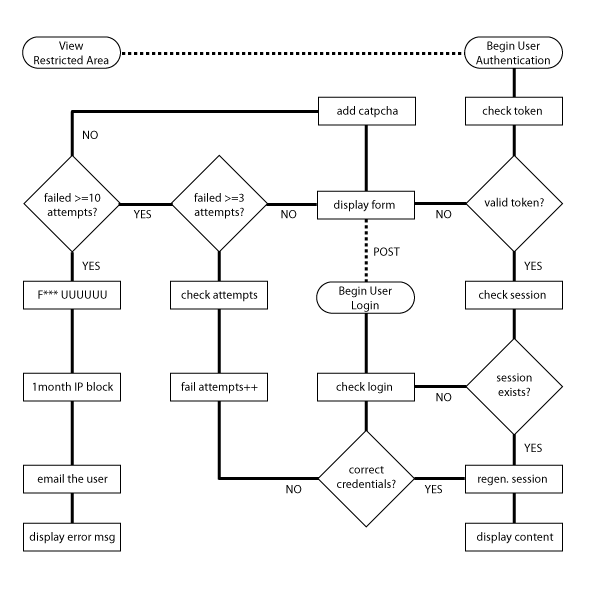This is a response to my previous question, Is this admin area secure enough?.
There were some very helpful answers there, for which I am very grateful. So I went back to the drawing board and here is my new question, because I'm new to the security side of things and I'm not sure if I've understood or covered all of the loop holes correctly.
The problems I'm trying to protect the system against are:
- Man in the Middle attacks
- SQL injection attacks
- CSRF attacks
- XSS attacks
- Click jacks
- Brute force attacks
Notes
- Passwords are stored with this implementation of bcrypt
- The entire site will use the https:// protocol
- Flags session.cookie_secure and session.cookie_httponly will be set
- PHP's PDO object is used in all SQL queries, all inputs are parameterized
- Any user input variables will be sanitized
- Every page will start with a
x-frame-options: denyhttp header - Every restricted page will start with an authorization script (see fig. 1)
- All forms will only be authorised if the set variable
$_SESSION["auth_key"]matches the key sent with the form (see fig. 1)
Fig.1: Authorization & Login Script

I hope this diagram is mostly self-explanatory. However, I will try to clarify certain functions.
- check token: A token that is generated once a user logs in, stored in
$_SESSION['auth_token']and sent with any form the user submits. - check session: If the user has a valid token, pull their details from the database using the PHPSESSID (the name is required to welcome back the user). If the session id is not found or the token is invalid, their session has expired and they need to login again.
- regen. session: Once the user is logged in successfully, give them a new session id (
session_regenerate_id()) and update the database with the new session id. Set the$_SESSION['auth_token'] = md5(mt_rand(1,10000).$username);. The username is unique so this should generate a unique auth token so they may submit their own forms. I'm not sure if I've implemented this correctly - please see the example here - check login: Simply checks the bcrypted password matches the bcrypted input, and usernames match.
- fail attempts: This side is added to slow down brute force attacks; first a captcha is added, then the IP is temporarily blocked and the user/account holder is sent an email of notification.
- I will add more detail if necessary/correct these details if there are any mistakes
Implementation (so far):
Restricted page: starts with requirement of authenticate.php
<?php require_once "authenticate.php"; ?>
<p>Welcome <?php echo $_SESSION["guest"]; ?>!
<a href="index.php?action=logout">Logout</a></p>
<p><a href="index.php?token=<?php echo $_SESSION["auth_token"] ?>">Try again.</a></p>
Authenticate.php: redirects to login.php if not authenticated
Note: I left encryption out (while testing) because bcrypt is unavailable in my version of PHP (5.2.17) so I'm looking for either SHA256 or SHA512.
<?php
session_start();
// load database abstraction layer
require_once "../../dal.php";
unset($_SESSION["login_errors"]);
function loginError($str) {
if (isset($_SESSION["login_errors"]))
$_SESSION["login_errors"] = "" . $_SESSION["login_errors"] . "; " . $str;
else
$_SESSION["login_errors"] = $str;
}
function hasValidToken() {
return (isset($_SESSION["auth_token"]) && isset($_GET["token"])
&& $_SESSION["auth_token"] == $_GET["token"]);
}
function hasValidSession() {
return (session_id()? hasOpenSession() : false);
}
function hasOpenSession() {
$sql = "SELECT * FROM tbl_store_admin WHERE php_sesskey=?;";
$data = array(session_id());
return (dbRowsCount($sql, $data) == 1);
}
function updateUserSession() {
$sql = "UPDATE tbl_store_admin SET php_sesskey=? WHERE username=?";
$data = array(session_id(), $_SESSION["uid"]);
dbQuery($sql, $data);
return (dbRowsAffected() == 1);
}
function hasLoggedIn() {
if (isset($_POST["uid"]) && isset($_POST["key"])) {
$uid = htmlspecialchars($_POST["uid"]);
$key = htmlspecialchars($_POST["key"]);
return (getUser($uid, $key));
} else {
return false;
}
}
function wrongCredentials() {
if (isset($_SESSION["login_attempts"])) {
$_SESSION["login_attempts"] = $_SESSION["login_attempts"]+1;
} else {
$_SESSION["login_attempts"] = 1;
}
logout();
loginError("Bad Credentials");
return false;
}
function getUser($uid, $key) {
$sql = "SELECT * FROM tbl_store_admin WHERE username=? AND keycode=? LIMIT 1;";
$data = array($uid, $key);
$rows = dbRowsCount($sql, $data);
if ($rows == 1) {
dbQuery($sql, $data);
$user = dbFetch();
// store data in session
$_SESSION["uid"] = $user["username"];
$_SESSION["guest"] = $user["nickname"];
return true;
} else {
return wrongCredentials();
}
}
function logout() {
if (isset($_SESSION["auth_token"])) {
unset($_SESSION["auth_token"]);
}
if (isset($_SESSION["uid"])) {
$sql = "UPDATE tbl_store_admin SET php_sesskey=NULL WHERE username=?;";
$data = array($_SESSION["uid"]);
dbQuery($sql, $data);
unset($_SESSION["uid"]);
}
if (isset($_SESSION["guest"])) {
unset($_SESSION["guest"]);
}
}
function hasAuthenticated() {
if (hasValidToken()) {
if (hasValidSession()) {
return true;
} else {
logout();
return false;
}
} else {
logout();
return hasLoggedIn();
}
}
function regenerateSession() {
session_regenerate_id();
updateUserSession();
$token = "" . mt_rand(1,10000) . $_SESSION["uid"];
$_SESSION["auth_token"] = md5($token);
}
if (isset($_GET["action"]) && $_GET["action"]=="logout") {
logout();
}
if (!hasAuthenticated()) {
header('Location: login.php');
} else {
regenerateSession();
}
?>
Login.php: A simple login form
<?php
session_start();
function getRequestURL() {
if (isset($_SESSION['HTTP_REFERER'])) {
return $_SESSION['HTTP_REFERER'];
}
return "index.php?token=".$_SESSION["auth_token"];
}
?>
<!DOCTYPE HTML PUBLIC "-//W3C//DTD HTML 4.01 Transitional//EN"
"http://www.w3.org/TR/html4/loose.dtd">
<html>
<head>
<meta http-equiv="X-Frame-Options" content="deny">
<title>Admin Login</title>
<style type="text/css">
.errorbox {
position:absolute;
top:0px;
left:0px;
width:100%;
height:100px;
background-color:#FFAAAA;
border:1px solid #FF0000;
}
.loginbox {
width:600px;
height:300px;
border:5px solid #000000;
margin:100px auto;
border-radius:10px;
-moz-border-radius:10px;
-webkit-border-radius:10px;
background-color:#CCCCCC;
box-shadow:4px 4px 2px #999999;
-moz-box-shadow:4px 4px 2px #999999;
-webkit-box-shadow:4px 4px 2px #999999;
}
.formbox {
width:400px;
height:200px;
margin:0px auto;
}
.label {
width:120px;
height:40px;
text-align:right;
line-height:40px;
float:left;
font-weight:bold;
}
.textinput {
height:40px;
width:260px;
font-size:30px;
line-height:40px;
}
.submitbtn {
height:50px;
width:100px;
font-size:30px;
line-height:40px;
}
</style>
</head>
<body style="font-family: Arial;font-size:20px;">
<?php
if (isset($_SESSION["login_errors"])) {
?>
<div class="errorbox">
Error: <?php echo ($_SESSION["login_errors"]); ?>
</div>
<?php
}
?>
<div class="loginbox">
<h1 align="center">Admin Area</h1>
<div class="formbox">
<form action="<?php echo getRequestURL(); ?>" method="POST">
<p><big>
<div class="label">Name:</div>
<input class="textinput" type="text" name="uid"/><br>
<div class="label">Password:</div>
<input class="textinput" type="password" name="key"/><br>
</big></p>
<p align="right"><input class="submitbtn" type="submit" value="Log In"/></p>
</form>
</div>
</div>
</body>
</html>

x-frame-optoins: denyhttp header.login.php, it will check the value of failed login attempts, and depending on that display no captcha or increasingly difficult captchas.